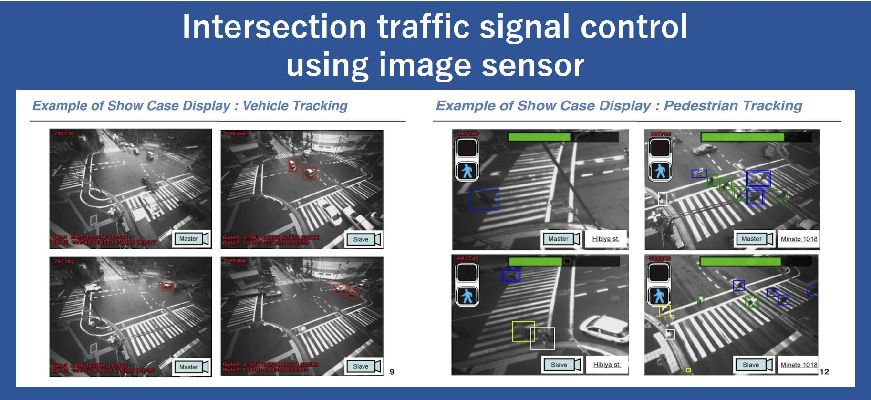
交通インフラ - 交通信号制御
Traffic Infrastructure - Traffic Signal Control
従来、交通信号制御には超音波ループセンサーが交通量や速度、飽和度を計測するために用いられてきました。 SCATS(Sydney Coordinated Adaptive Traffic System)のアルゴリズムは、交差点に接続する各道路にループセンサーを用います。 本研究では、複数のループセンサーを集約可能な先進的な画像センサを開発し、これを用いて2013年10月東京でのITS世界会議のショーケースにおいてデモンストレーションを行いました。 一つの目的は、交差する二つ道路の交通量に応じて車両用信号スプリットを最適化することです。 またもう一つの目的は、歩行者の位置、姿勢、速度に応じて歩行者用信号スプリットを最適化することです。 歩行者の青信号時間を短くすることは、車両の左折時の混雑の解消に効果的でした。 逆に、歩行者の青信号時間を長くすることで、お年寄りや障害者が安全に横断し終えることができました。 車両と歩行者の計測機能を集約した先進的な画像センサが、車両-歩行者間の信号の最適化に有用であることを示しました。
Traditionally, loop detectors ultrasonic sensors have been used for traffic signal controls to measure traffic volume, velocity, degree of saturation. SCATS algorithm employs loop detectors at each approaching road to the intersection. We developed an Intelligent Vision Sensor which can replace multiple loop detectors by a single sensor. Using the sensor, we performed demonstration in Showcase of ITS World Congress, Tokyo, in October 2013. One of the objectives is to optimize split of the vehicle signal referring to traffic volume of the two crossing road. The other objectives are to optimize pedestrian signal referring to position and walking direction and speed of pedestrians. To shorten pedestrian green time is effective for avoiding left turn (right turn in US and EU) congestion of vehicle traffic. To extend pedestrian green time is helpful for elderly and handicapped persons to safely complete the crossings. The Intelligent Vision Sensor integrates the functions of vehicle and pedestrian tracking, and has been proved to be useful for signal optimization between vehicles and pedestrians.